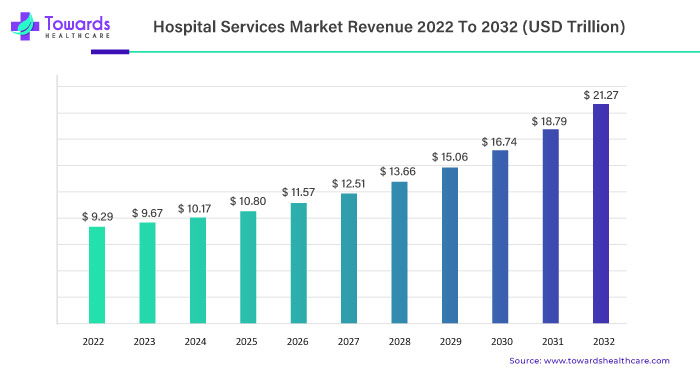
The healthcare industry is undergoing a significant transformation as the traditional fee-for-service (FFS) model is gradually replaced by a value-based care approach. This shift in focus moves away from simply reimbursing healthcare providers based on the volume of services delivered and instead emphasizes achieving better health outcomes for patients while simultaneously reducing costs. For the hospital services market, this change presents several opportunities to enhance care delivery, improve financial performance, and drive long-term sustainability.
The global hospital services market is experiencing rapid growth, estimated to expand from USD 9.29 trillion in 2022 to USD 21.27 trillion by 2032, at a compound annual growth rate (CAGR) of 9.15%. This growth is driven by technological advancements and a growing shift towards health management, which is reshaping how healthcare providers deliver care and interact with patients.

Get All the Details on Our Solutions – Brochure Download @ https://www.towardshealthcare.com/download-brochure/5041
Embracing Care Coordination to Improve Patient Care
One of the most critical components of the value-based care model is care coordination. Hospitals can play a central role in improving patient outcomes by ensuring that patients receive the right care at the right time. Care coordination involves improving communication between primary care physicians, specialists, hospital staff, and patients, so that everyone involved in the patient’s care is on the same page.
By implementing robust care coordination strategies, hospitals can ensure a seamless patient experience, prevent unnecessary hospital readmissions, and reduce delays in care. This comprehensive approach not only improves patient satisfaction but also helps hospitals achieve the quality outcomes necessary for success under value-based models.
Leveraging Technology to Drive Efficiency and Reduce Costs
Technology is a powerful tool that can help hospitals streamline operations and improve care delivery, both of which are critical for success in a value-based healthcare environment. The implementation of Electronic Health Records (EHRs) is one such technology that enhances efficiency by consolidating patient data and ensuring that healthcare providers have access to up-to-date information.
EHRs can reduce errors, improve diagnosis accuracy, and enable providers to make more informed treatment decisions. Additionally, hospitals can use telehealth to extend care services beyond the hospital walls. Telehealth allows for remote consultations and follow-up visits, reducing the need for in-person visits, which can be costly and time-consuming.
These technological solutions not only improve operational efficiency but also help hospitals deliver high-quality care at lower costs, supporting the shift toward value-based models.
Fostering Patient-Centered Care and Improving Satisfaction
Patient satisfaction is another key factor in the success of value-based healthcare. Under this model, hospitals are incentivized to improve patient outcomes, which includes ensuring that patients are satisfied with their care experience. Hospitals can achieve this by focusing on patient-centered care, a holistic approach that prioritizes the needs and preferences of patients.
To foster patient-centered care, hospitals can implement programs that educate patients, promote wellness, and provide support throughout the treatment process. Patient education helps patients make informed decisions about their health and treatment options, while wellness programs encourage proactive health management and disease prevention.
By prioritizing patient needs and focusing on outcomes that matter most to patients, hospitals can improve both clinical results and patient satisfaction. These efforts not only align with the goals of value-based care but also lead to better financial performance, as satisfied patients are more likely to remain loyal to their healthcare providers.
Collaboration with Payers and Healthcare Providers
A successful value-based healthcare model requires collaboration among various stakeholders in the healthcare system. Hospitals must work closely with payers (such as insurance companies) and other healthcare providers to develop and implement value-based payment models. These models incentivize quality care and improved patient outcomes rather than the volume of services rendered.
By aligning goals with payers and other providers, hospitals can achieve shared objectives, such as reducing hospital readmissions, improving patient outcomes, and controlling healthcare costs. This collaboration can also help hospitals avoid penalties for suboptimal care and position them for success in an increasingly competitive healthcare environment.
Our Table of Content (TOC) covers key healthcare market segments, materials, technologies and trends—helping you navigate market shifts and make informed decisions: https://www.towardshealthcare.com/table-of-content/hospital-services-market-transformation-from-treatment-to-health-management
Invest in Our Premium Strategic Solution @ https://www.towardshealthcare.com/price/5041
We’ve prepared a service to support you. Please feel free to contact us at sales@towardshealthcare.com
Web: https://www.towardshealthcare.com
Visit Dental Specifics: https://www.towardsdental.com
Get the latest insights on industry segmentation with our Annual Membership: Get a Subscription
For Latest Update Follow Us: https://www.linkedin.com/company/towards-healthcare



